Strategic Leadership in the 21st Century: A Comparative Analysis
VerifiedAdded on 2022/09/14
|8
|1897
|10
Essay
AI Summary
This essay provides a comparative analysis of strategic leadership, drawing on the works of Ireland & Hitt (2005) and Hitt, Haynes, & Serpa (2010). The introduction highlights the increasing complexity and competitiveness of the 21st-century global economy, emphasizing the crucial role of effective leadership in navigating unpredictable business environments. The essay contrasts the authors' perspectives on strategic leadership, focusing on their predictions for future organizational practices, the importance of innovation, and the role of strategic leaders in fostering competitive advantages. The comparative discussion examines the drivers of economic growth, the accountability of CEOs, and the importance of human capital and organizational culture. The self-reflection section discusses the practical applications of the analyzed concepts and insights gained for future career and organizational growth. The conclusion summarizes the key arguments, emphasizing the need for strategic leaders to operate in uncertain business conditions by predicting future challenges, employing an entrepreneurial mindset, and leveraging opportunities. The essay underscores the importance of developing a strong vision, ethical practices, and core competencies to achieve long-term success in the global economy.
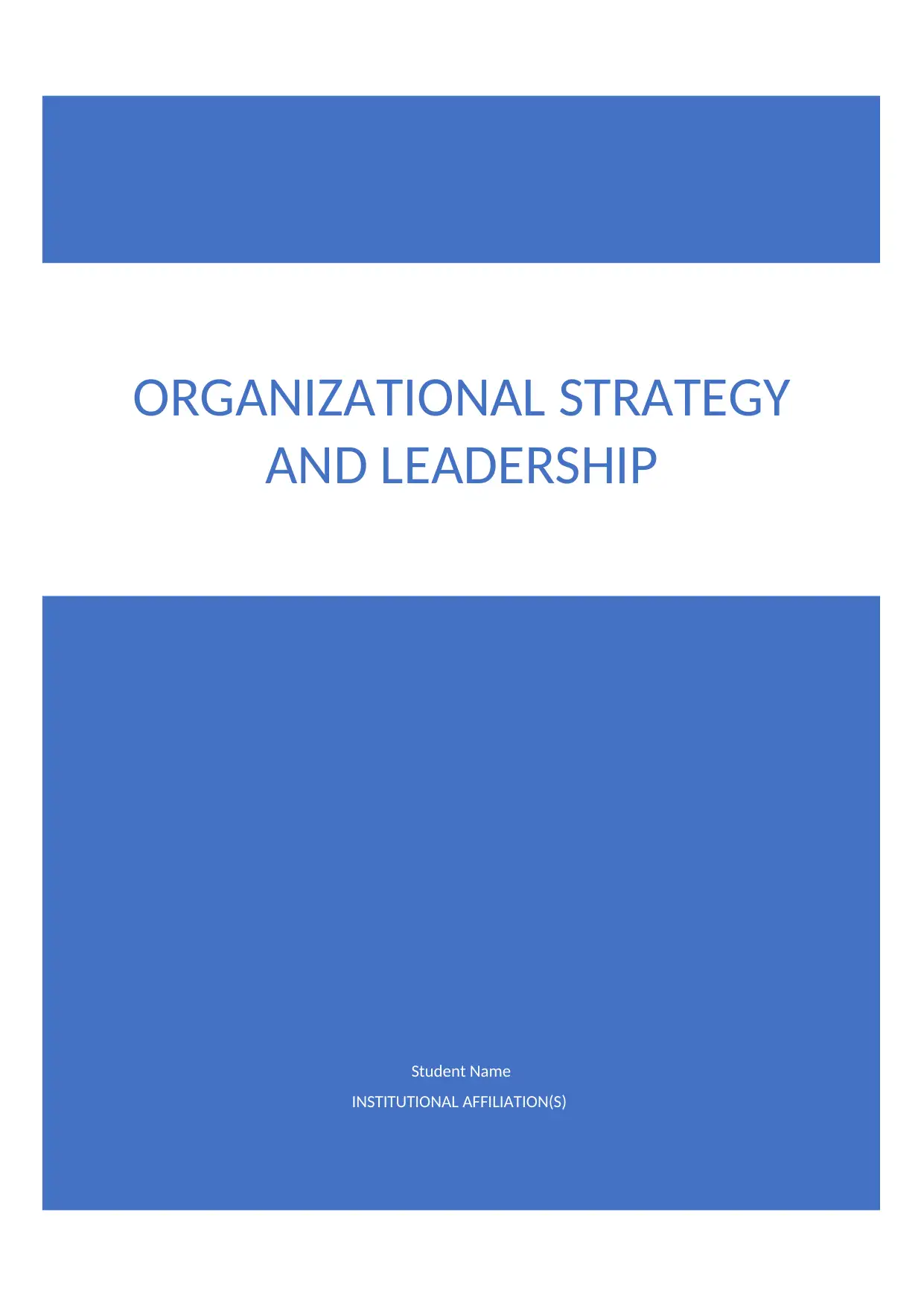
Student Name
INSTITUTIONAL AFFILIATION(S)
ORGANIZATIONAL STRATEGY
AND LEADERSHIP
INSTITUTIONAL AFFILIATION(S)
ORGANIZATIONAL STRATEGY
AND LEADERSHIP
Paraphrase This Document
Need a fresh take? Get an instant paraphrase of this document with our AI Paraphraser
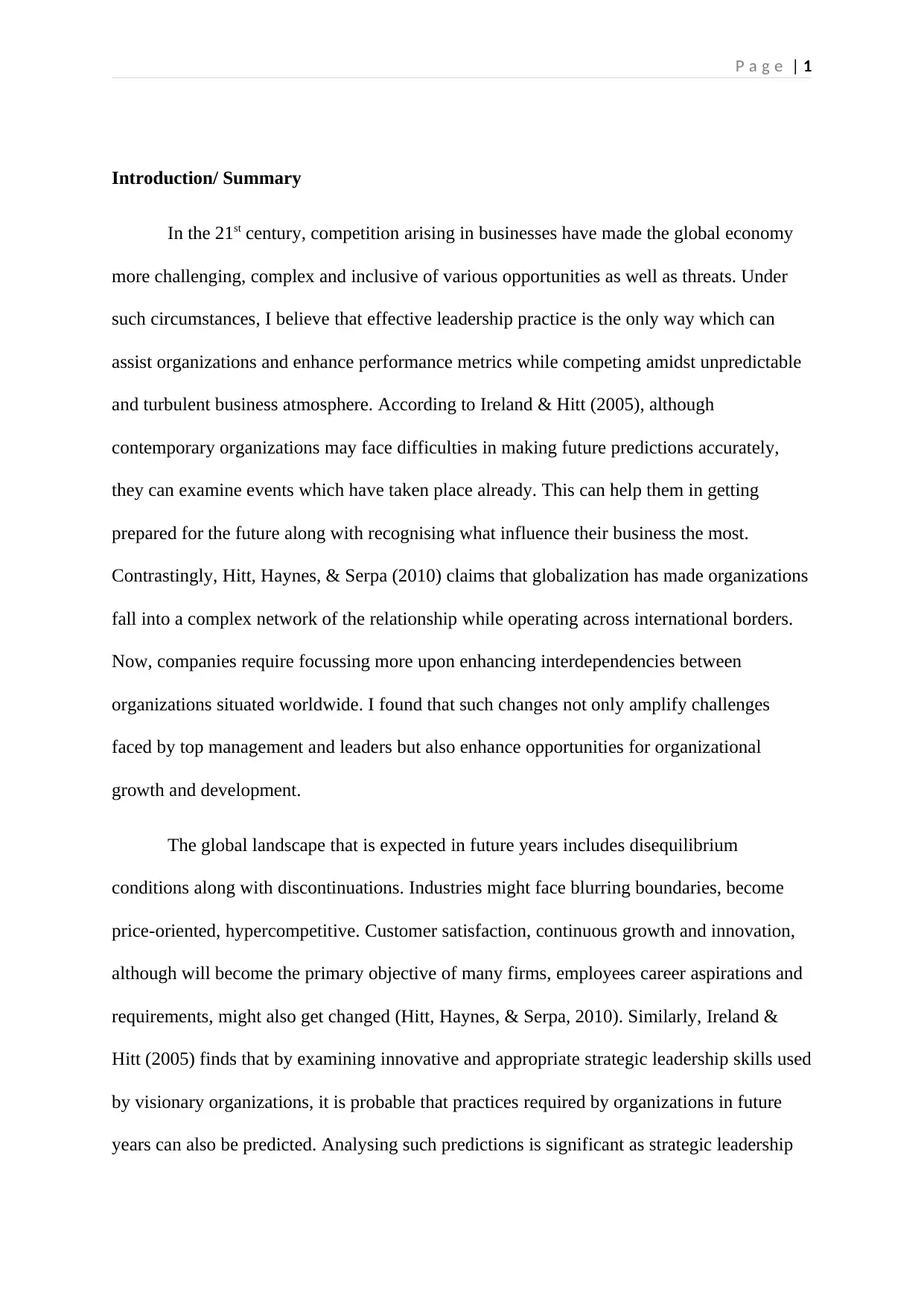
P a g e | 1
Introduction/ Summary
In the 21st century, competition arising in businesses have made the global economy
more challenging, complex and inclusive of various opportunities as well as threats. Under
such circumstances, I believe that effective leadership practice is the only way which can
assist organizations and enhance performance metrics while competing amidst unpredictable
and turbulent business atmosphere. According to Ireland & Hitt (2005), although
contemporary organizations may face difficulties in making future predictions accurately,
they can examine events which have taken place already. This can help them in getting
prepared for the future along with recognising what influence their business the most.
Contrastingly, Hitt, Haynes, & Serpa (2010) claims that globalization has made organizations
fall into a complex network of the relationship while operating across international borders.
Now, companies require focussing more upon enhancing interdependencies between
organizations situated worldwide. I found that such changes not only amplify challenges
faced by top management and leaders but also enhance opportunities for organizational
growth and development.
The global landscape that is expected in future years includes disequilibrium
conditions along with discontinuations. Industries might face blurring boundaries, become
price-oriented, hypercompetitive. Customer satisfaction, continuous growth and innovation,
although will become the primary objective of many firms, employees career aspirations and
requirements, might also get changed (Hitt, Haynes, & Serpa, 2010). Similarly, Ireland &
Hitt (2005) finds that by examining innovative and appropriate strategic leadership skills used
by visionary organizations, it is probable that practices required by organizations in future
years can also be predicted. Analysing such predictions is significant as strategic leadership
Introduction/ Summary
In the 21st century, competition arising in businesses have made the global economy
more challenging, complex and inclusive of various opportunities as well as threats. Under
such circumstances, I believe that effective leadership practice is the only way which can
assist organizations and enhance performance metrics while competing amidst unpredictable
and turbulent business atmosphere. According to Ireland & Hitt (2005), although
contemporary organizations may face difficulties in making future predictions accurately,
they can examine events which have taken place already. This can help them in getting
prepared for the future along with recognising what influence their business the most.
Contrastingly, Hitt, Haynes, & Serpa (2010) claims that globalization has made organizations
fall into a complex network of the relationship while operating across international borders.
Now, companies require focussing more upon enhancing interdependencies between
organizations situated worldwide. I found that such changes not only amplify challenges
faced by top management and leaders but also enhance opportunities for organizational
growth and development.
The global landscape that is expected in future years includes disequilibrium
conditions along with discontinuations. Industries might face blurring boundaries, become
price-oriented, hypercompetitive. Customer satisfaction, continuous growth and innovation,
although will become the primary objective of many firms, employees career aspirations and
requirements, might also get changed (Hitt, Haynes, & Serpa, 2010). Similarly, Ireland &
Hitt (2005) finds that by examining innovative and appropriate strategic leadership skills used
by visionary organizations, it is probable that practices required by organizations in future
years can also be predicted. Analysing such predictions is significant as strategic leadership
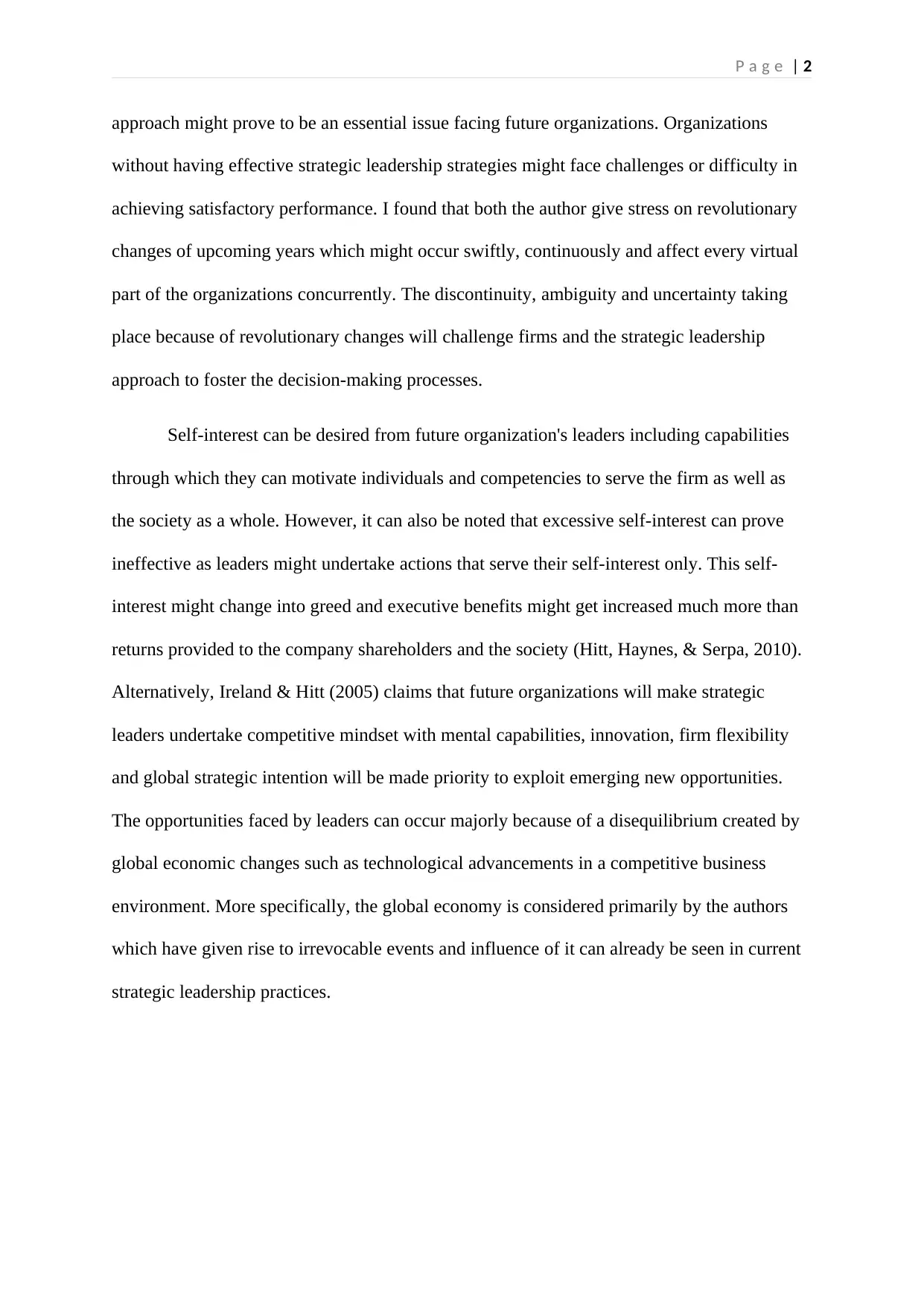
P a g e | 2
approach might prove to be an essential issue facing future organizations. Organizations
without having effective strategic leadership strategies might face challenges or difficulty in
achieving satisfactory performance. I found that both the author give stress on revolutionary
changes of upcoming years which might occur swiftly, continuously and affect every virtual
part of the organizations concurrently. The discontinuity, ambiguity and uncertainty taking
place because of revolutionary changes will challenge firms and the strategic leadership
approach to foster the decision-making processes.
Self-interest can be desired from future organization's leaders including capabilities
through which they can motivate individuals and competencies to serve the firm as well as
the society as a whole. However, it can also be noted that excessive self-interest can prove
ineffective as leaders might undertake actions that serve their self-interest only. This self-
interest might change into greed and executive benefits might get increased much more than
returns provided to the company shareholders and the society (Hitt, Haynes, & Serpa, 2010).
Alternatively, Ireland & Hitt (2005) claims that future organizations will make strategic
leaders undertake competitive mindset with mental capabilities, innovation, firm flexibility
and global strategic intention will be made priority to exploit emerging new opportunities.
The opportunities faced by leaders can occur majorly because of a disequilibrium created by
global economic changes such as technological advancements in a competitive business
environment. More specifically, the global economy is considered primarily by the authors
which have given rise to irrevocable events and influence of it can already be seen in current
strategic leadership practices.
approach might prove to be an essential issue facing future organizations. Organizations
without having effective strategic leadership strategies might face challenges or difficulty in
achieving satisfactory performance. I found that both the author give stress on revolutionary
changes of upcoming years which might occur swiftly, continuously and affect every virtual
part of the organizations concurrently. The discontinuity, ambiguity and uncertainty taking
place because of revolutionary changes will challenge firms and the strategic leadership
approach to foster the decision-making processes.
Self-interest can be desired from future organization's leaders including capabilities
through which they can motivate individuals and competencies to serve the firm as well as
the society as a whole. However, it can also be noted that excessive self-interest can prove
ineffective as leaders might undertake actions that serve their self-interest only. This self-
interest might change into greed and executive benefits might get increased much more than
returns provided to the company shareholders and the society (Hitt, Haynes, & Serpa, 2010).
Alternatively, Ireland & Hitt (2005) claims that future organizations will make strategic
leaders undertake competitive mindset with mental capabilities, innovation, firm flexibility
and global strategic intention will be made priority to exploit emerging new opportunities.
The opportunities faced by leaders can occur majorly because of a disequilibrium created by
global economic changes such as technological advancements in a competitive business
environment. More specifically, the global economy is considered primarily by the authors
which have given rise to irrevocable events and influence of it can already be seen in current
strategic leadership practices.
⊘ This is a preview!⊘
Do you want full access?
Subscribe today to unlock all pages.

Trusted by 1+ million students worldwide
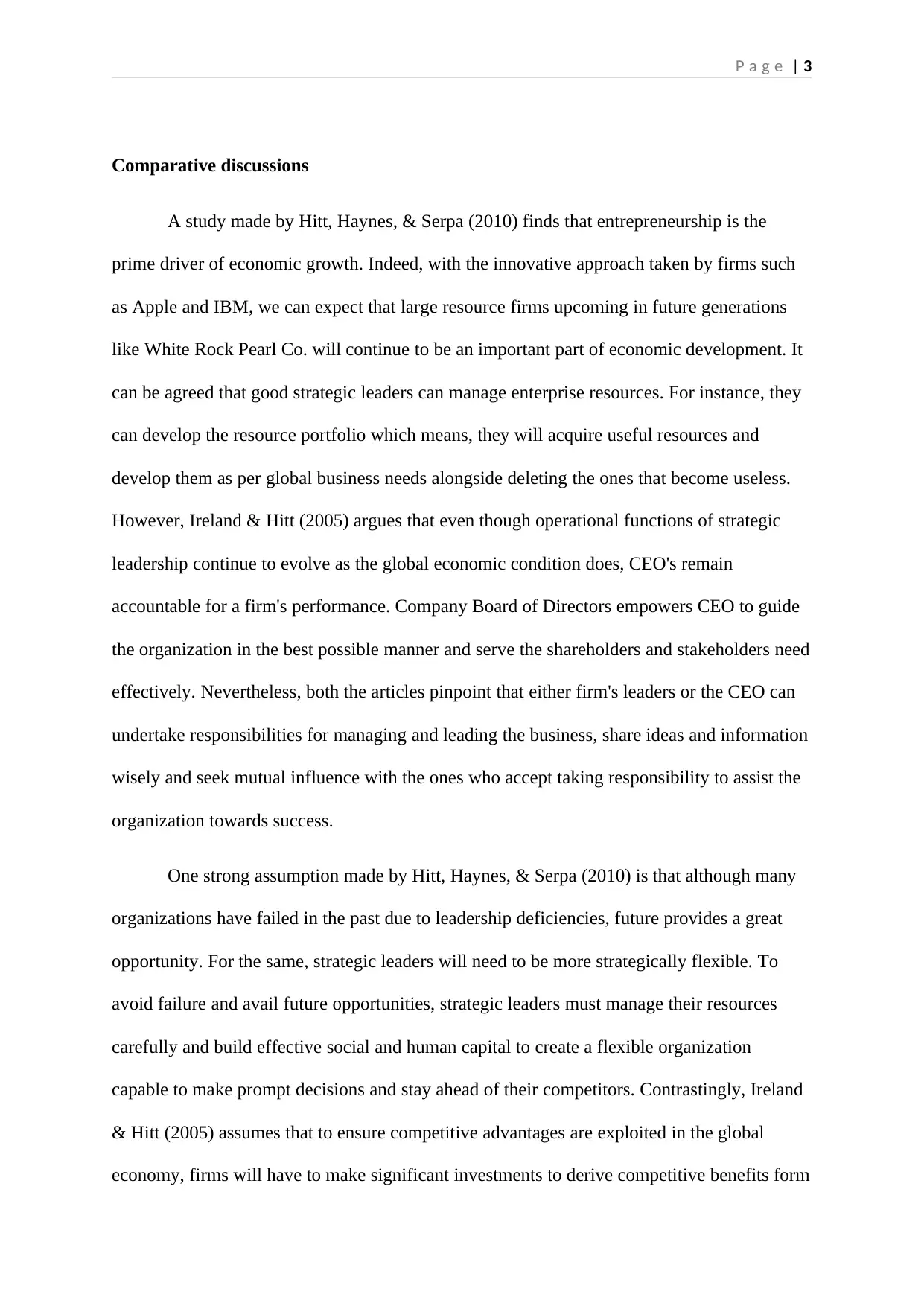
P a g e | 3
Comparative discussions
A study made by Hitt, Haynes, & Serpa (2010) finds that entrepreneurship is the
prime driver of economic growth. Indeed, with the innovative approach taken by firms such
as Apple and IBM, we can expect that large resource firms upcoming in future generations
like White Rock Pearl Co. will continue to be an important part of economic development. It
can be agreed that good strategic leaders can manage enterprise resources. For instance, they
can develop the resource portfolio which means, they will acquire useful resources and
develop them as per global business needs alongside deleting the ones that become useless.
However, Ireland & Hitt (2005) argues that even though operational functions of strategic
leadership continue to evolve as the global economic condition does, CEO's remain
accountable for a firm's performance. Company Board of Directors empowers CEO to guide
the organization in the best possible manner and serve the shareholders and stakeholders need
effectively. Nevertheless, both the articles pinpoint that either firm's leaders or the CEO can
undertake responsibilities for managing and leading the business, share ideas and information
wisely and seek mutual influence with the ones who accept taking responsibility to assist the
organization towards success.
One strong assumption made by Hitt, Haynes, & Serpa (2010) is that although many
organizations have failed in the past due to leadership deficiencies, future provides a great
opportunity. For the same, strategic leaders will need to be more strategically flexible. To
avoid failure and avail future opportunities, strategic leaders must manage their resources
carefully and build effective social and human capital to create a flexible organization
capable to make prompt decisions and stay ahead of their competitors. Contrastingly, Ireland
& Hitt (2005) assumes that to ensure competitive advantages are exploited in the global
economy, firms will have to make significant investments to derive competitive benefits form
Comparative discussions
A study made by Hitt, Haynes, & Serpa (2010) finds that entrepreneurship is the
prime driver of economic growth. Indeed, with the innovative approach taken by firms such
as Apple and IBM, we can expect that large resource firms upcoming in future generations
like White Rock Pearl Co. will continue to be an important part of economic development. It
can be agreed that good strategic leaders can manage enterprise resources. For instance, they
can develop the resource portfolio which means, they will acquire useful resources and
develop them as per global business needs alongside deleting the ones that become useless.
However, Ireland & Hitt (2005) argues that even though operational functions of strategic
leadership continue to evolve as the global economic condition does, CEO's remain
accountable for a firm's performance. Company Board of Directors empowers CEO to guide
the organization in the best possible manner and serve the shareholders and stakeholders need
effectively. Nevertheless, both the articles pinpoint that either firm's leaders or the CEO can
undertake responsibilities for managing and leading the business, share ideas and information
wisely and seek mutual influence with the ones who accept taking responsibility to assist the
organization towards success.
One strong assumption made by Hitt, Haynes, & Serpa (2010) is that although many
organizations have failed in the past due to leadership deficiencies, future provides a great
opportunity. For the same, strategic leaders will need to be more strategically flexible. To
avoid failure and avail future opportunities, strategic leaders must manage their resources
carefully and build effective social and human capital to create a flexible organization
capable to make prompt decisions and stay ahead of their competitors. Contrastingly, Ireland
& Hitt (2005) assumes that to ensure competitive advantages are exploited in the global
economy, firms will have to make significant investments to derive competitive benefits form
Paraphrase This Document
Need a fresh take? Get an instant paraphrase of this document with our AI Paraphraser
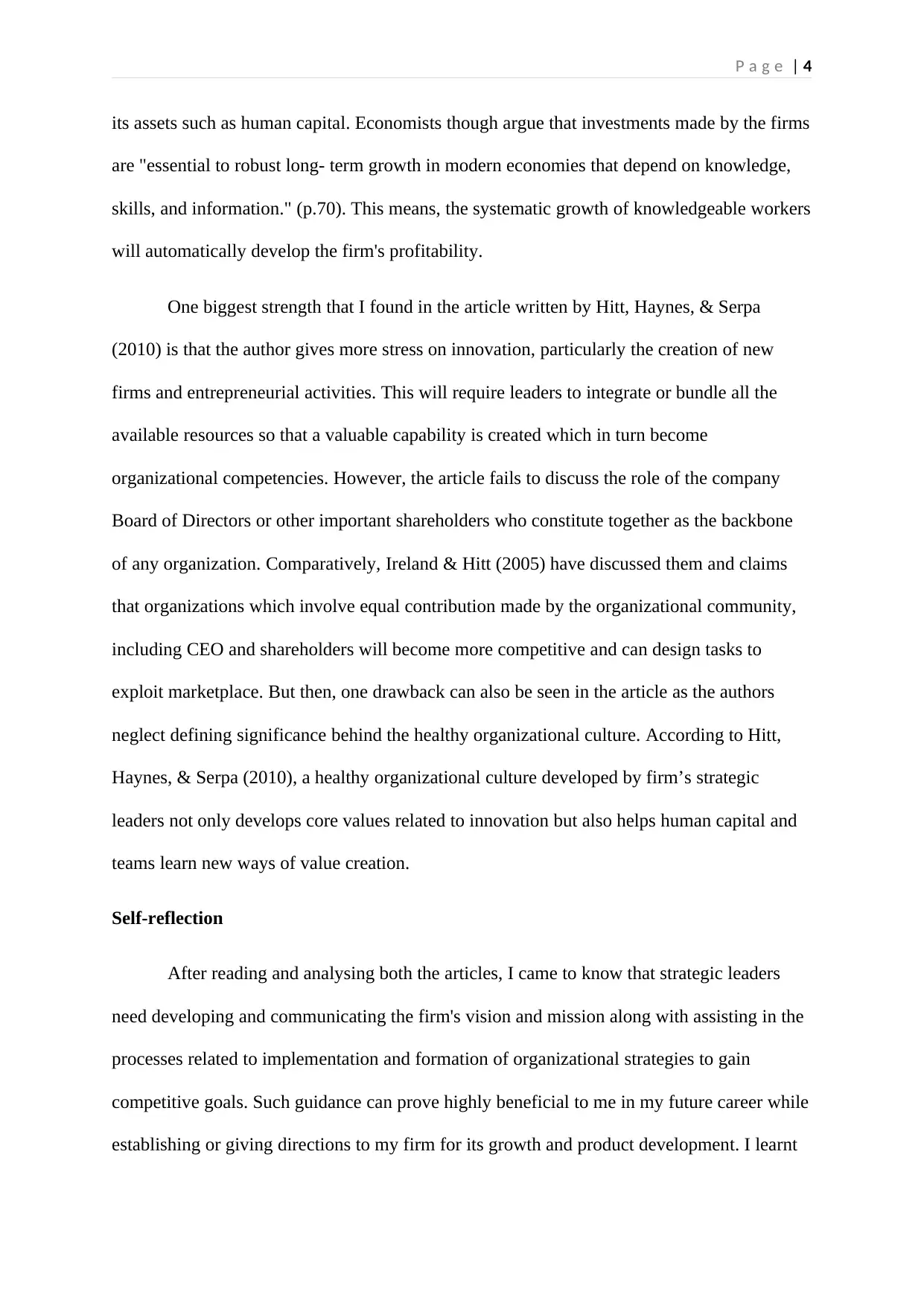
P a g e | 4
its assets such as human capital. Economists though argue that investments made by the firms
are "essential to robust long- term growth in modern economies that depend on knowledge,
skills, and information." (p.70). This means, the systematic growth of knowledgeable workers
will automatically develop the firm's profitability.
One biggest strength that I found in the article written by Hitt, Haynes, & Serpa
(2010) is that the author gives more stress on innovation, particularly the creation of new
firms and entrepreneurial activities. This will require leaders to integrate or bundle all the
available resources so that a valuable capability is created which in turn become
organizational competencies. However, the article fails to discuss the role of the company
Board of Directors or other important shareholders who constitute together as the backbone
of any organization. Comparatively, Ireland & Hitt (2005) have discussed them and claims
that organizations which involve equal contribution made by the organizational community,
including CEO and shareholders will become more competitive and can design tasks to
exploit marketplace. But then, one drawback can also be seen in the article as the authors
neglect defining significance behind the healthy organizational culture. According to Hitt,
Haynes, & Serpa (2010), a healthy organizational culture developed by firm’s strategic
leaders not only develops core values related to innovation but also helps human capital and
teams learn new ways of value creation.
Self-reflection
After reading and analysing both the articles, I came to know that strategic leaders
need developing and communicating the firm's vision and mission along with assisting in the
processes related to implementation and formation of organizational strategies to gain
competitive goals. Such guidance can prove highly beneficial to me in my future career while
establishing or giving directions to my firm for its growth and product development. I learnt
its assets such as human capital. Economists though argue that investments made by the firms
are "essential to robust long- term growth in modern economies that depend on knowledge,
skills, and information." (p.70). This means, the systematic growth of knowledgeable workers
will automatically develop the firm's profitability.
One biggest strength that I found in the article written by Hitt, Haynes, & Serpa
(2010) is that the author gives more stress on innovation, particularly the creation of new
firms and entrepreneurial activities. This will require leaders to integrate or bundle all the
available resources so that a valuable capability is created which in turn become
organizational competencies. However, the article fails to discuss the role of the company
Board of Directors or other important shareholders who constitute together as the backbone
of any organization. Comparatively, Ireland & Hitt (2005) have discussed them and claims
that organizations which involve equal contribution made by the organizational community,
including CEO and shareholders will become more competitive and can design tasks to
exploit marketplace. But then, one drawback can also be seen in the article as the authors
neglect defining significance behind the healthy organizational culture. According to Hitt,
Haynes, & Serpa (2010), a healthy organizational culture developed by firm’s strategic
leaders not only develops core values related to innovation but also helps human capital and
teams learn new ways of value creation.
Self-reflection
After reading and analysing both the articles, I came to know that strategic leaders
need developing and communicating the firm's vision and mission along with assisting in the
processes related to implementation and formation of organizational strategies to gain
competitive goals. Such guidance can prove highly beneficial to me in my future career while
establishing or giving directions to my firm for its growth and product development. I learnt
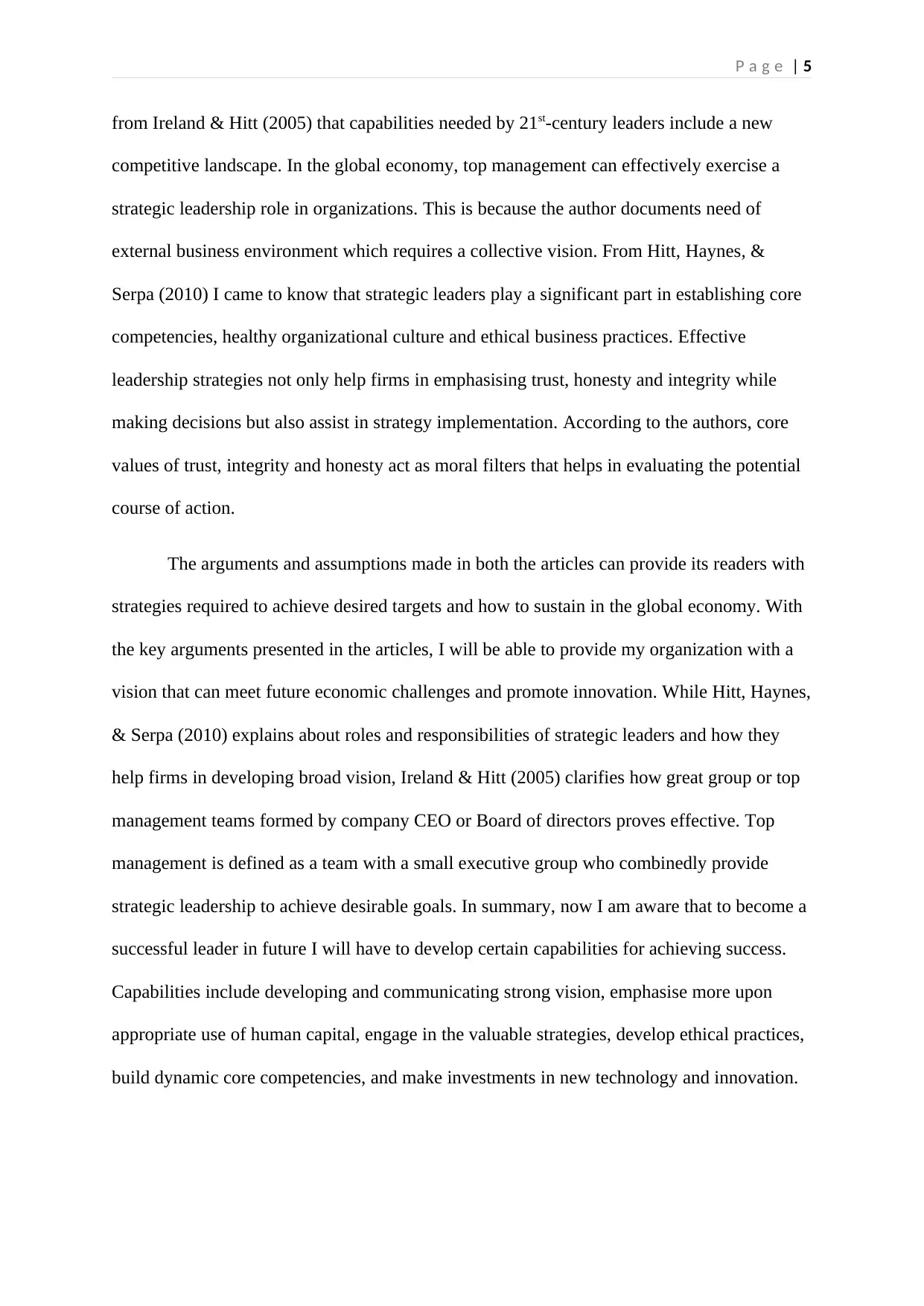
P a g e | 5
from Ireland & Hitt (2005) that capabilities needed by 21st-century leaders include a new
competitive landscape. In the global economy, top management can effectively exercise a
strategic leadership role in organizations. This is because the author documents need of
external business environment which requires a collective vision. From Hitt, Haynes, &
Serpa (2010) I came to know that strategic leaders play a significant part in establishing core
competencies, healthy organizational culture and ethical business practices. Effective
leadership strategies not only help firms in emphasising trust, honesty and integrity while
making decisions but also assist in strategy implementation. According to the authors, core
values of trust, integrity and honesty act as moral filters that helps in evaluating the potential
course of action.
The arguments and assumptions made in both the articles can provide its readers with
strategies required to achieve desired targets and how to sustain in the global economy. With
the key arguments presented in the articles, I will be able to provide my organization with a
vision that can meet future economic challenges and promote innovation. While Hitt, Haynes,
& Serpa (2010) explains about roles and responsibilities of strategic leaders and how they
help firms in developing broad vision, Ireland & Hitt (2005) clarifies how great group or top
management teams formed by company CEO or Board of directors proves effective. Top
management is defined as a team with a small executive group who combinedly provide
strategic leadership to achieve desirable goals. In summary, now I am aware that to become a
successful leader in future I will have to develop certain capabilities for achieving success.
Capabilities include developing and communicating strong vision, emphasise more upon
appropriate use of human capital, engage in the valuable strategies, develop ethical practices,
build dynamic core competencies, and make investments in new technology and innovation.
from Ireland & Hitt (2005) that capabilities needed by 21st-century leaders include a new
competitive landscape. In the global economy, top management can effectively exercise a
strategic leadership role in organizations. This is because the author documents need of
external business environment which requires a collective vision. From Hitt, Haynes, &
Serpa (2010) I came to know that strategic leaders play a significant part in establishing core
competencies, healthy organizational culture and ethical business practices. Effective
leadership strategies not only help firms in emphasising trust, honesty and integrity while
making decisions but also assist in strategy implementation. According to the authors, core
values of trust, integrity and honesty act as moral filters that helps in evaluating the potential
course of action.
The arguments and assumptions made in both the articles can provide its readers with
strategies required to achieve desired targets and how to sustain in the global economy. With
the key arguments presented in the articles, I will be able to provide my organization with a
vision that can meet future economic challenges and promote innovation. While Hitt, Haynes,
& Serpa (2010) explains about roles and responsibilities of strategic leaders and how they
help firms in developing broad vision, Ireland & Hitt (2005) clarifies how great group or top
management teams formed by company CEO or Board of directors proves effective. Top
management is defined as a team with a small executive group who combinedly provide
strategic leadership to achieve desirable goals. In summary, now I am aware that to become a
successful leader in future I will have to develop certain capabilities for achieving success.
Capabilities include developing and communicating strong vision, emphasise more upon
appropriate use of human capital, engage in the valuable strategies, develop ethical practices,
build dynamic core competencies, and make investments in new technology and innovation.
⊘ This is a preview!⊘
Do you want full access?
Subscribe today to unlock all pages.

Trusted by 1+ million students worldwide
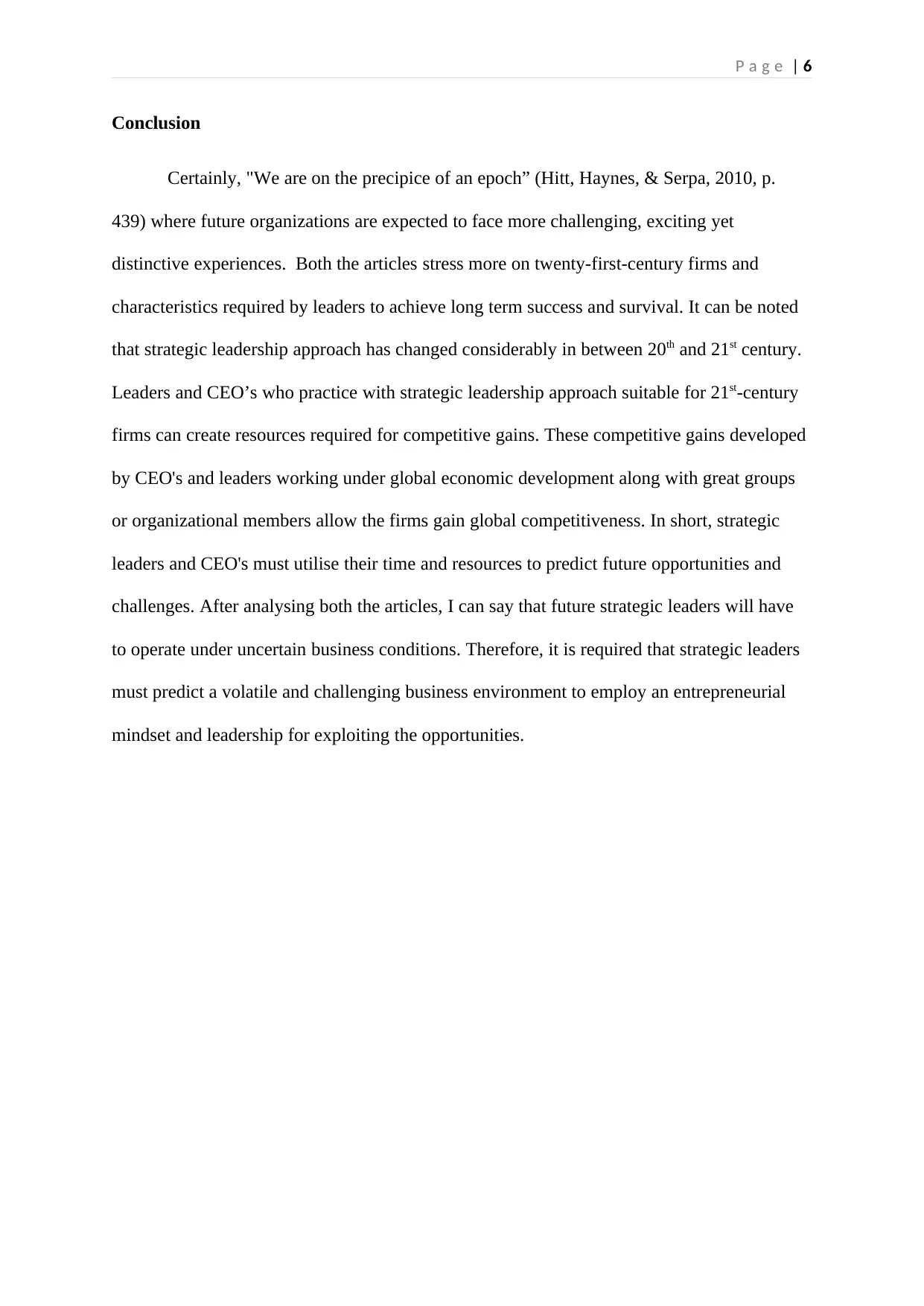
P a g e | 6
Conclusion
Certainly, "We are on the precipice of an epoch” (Hitt, Haynes, & Serpa, 2010, p.
439) where future organizations are expected to face more challenging, exciting yet
distinctive experiences. Both the articles stress more on twenty-first-century firms and
characteristics required by leaders to achieve long term success and survival. It can be noted
that strategic leadership approach has changed considerably in between 20th and 21st century.
Leaders and CEO’s who practice with strategic leadership approach suitable for 21st-century
firms can create resources required for competitive gains. These competitive gains developed
by CEO's and leaders working under global economic development along with great groups
or organizational members allow the firms gain global competitiveness. In short, strategic
leaders and CEO's must utilise their time and resources to predict future opportunities and
challenges. After analysing both the articles, I can say that future strategic leaders will have
to operate under uncertain business conditions. Therefore, it is required that strategic leaders
must predict a volatile and challenging business environment to employ an entrepreneurial
mindset and leadership for exploiting the opportunities.
Conclusion
Certainly, "We are on the precipice of an epoch” (Hitt, Haynes, & Serpa, 2010, p.
439) where future organizations are expected to face more challenging, exciting yet
distinctive experiences. Both the articles stress more on twenty-first-century firms and
characteristics required by leaders to achieve long term success and survival. It can be noted
that strategic leadership approach has changed considerably in between 20th and 21st century.
Leaders and CEO’s who practice with strategic leadership approach suitable for 21st-century
firms can create resources required for competitive gains. These competitive gains developed
by CEO's and leaders working under global economic development along with great groups
or organizational members allow the firms gain global competitiveness. In short, strategic
leaders and CEO's must utilise their time and resources to predict future opportunities and
challenges. After analysing both the articles, I can say that future strategic leaders will have
to operate under uncertain business conditions. Therefore, it is required that strategic leaders
must predict a volatile and challenging business environment to employ an entrepreneurial
mindset and leadership for exploiting the opportunities.
Paraphrase This Document
Need a fresh take? Get an instant paraphrase of this document with our AI Paraphraser
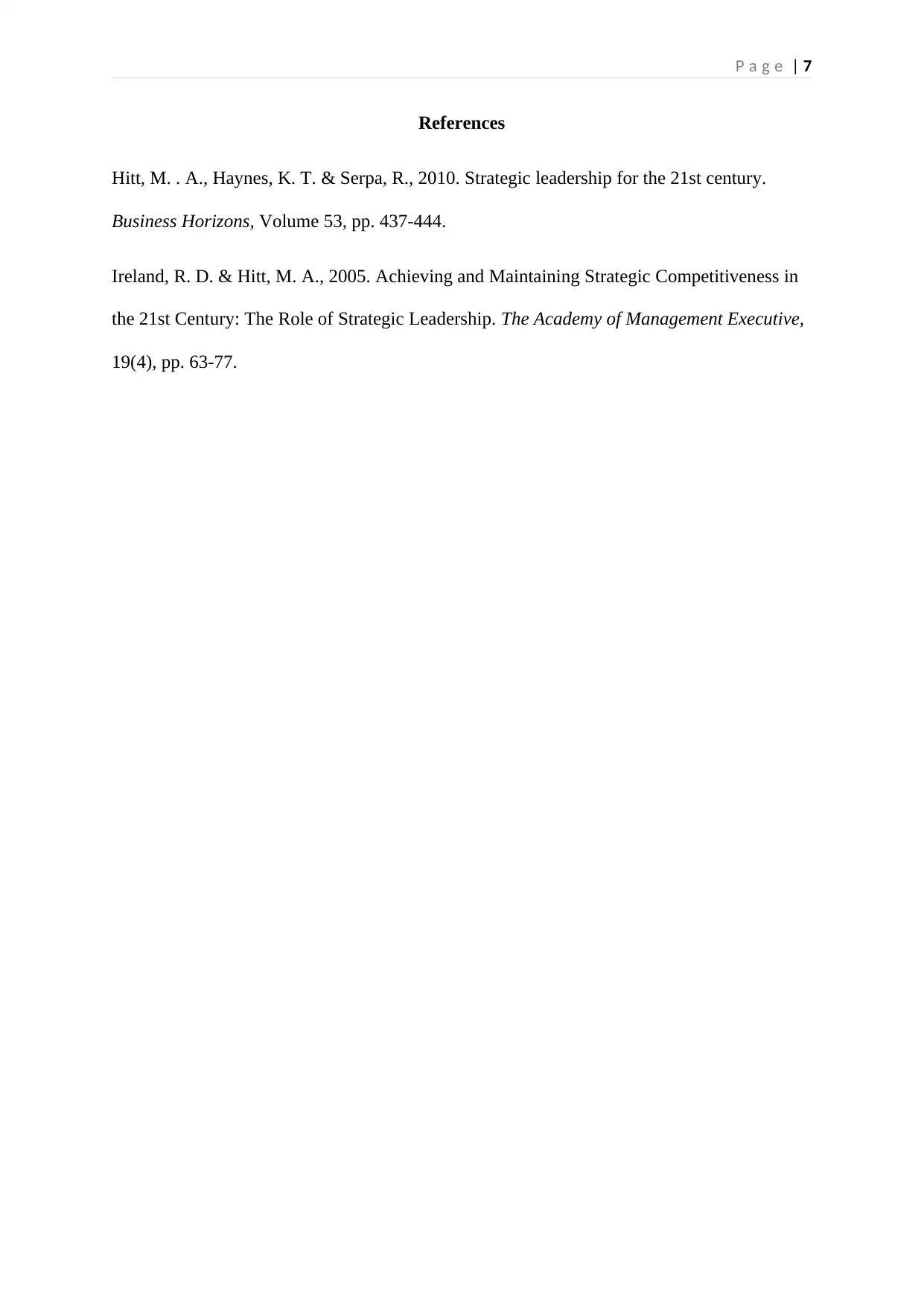
P a g e | 7
References
Hitt, M. . A., Haynes, K. T. & Serpa, R., 2010. Strategic leadership for the 21st century.
Business Horizons, Volume 53, pp. 437-444.
Ireland, R. D. & Hitt, M. A., 2005. Achieving and Maintaining Strategic Competitiveness in
the 21st Century: The Role of Strategic Leadership. The Academy of Management Executive,
19(4), pp. 63-77.
References
Hitt, M. . A., Haynes, K. T. & Serpa, R., 2010. Strategic leadership for the 21st century.
Business Horizons, Volume 53, pp. 437-444.
Ireland, R. D. & Hitt, M. A., 2005. Achieving and Maintaining Strategic Competitiveness in
the 21st Century: The Role of Strategic Leadership. The Academy of Management Executive,
19(4), pp. 63-77.
1 out of 8
Related Documents
Your All-in-One AI-Powered Toolkit for Academic Success.
+13062052269
info@desklib.com
Available 24*7 on WhatsApp / Email
![[object Object]](/_next/static/media/star-bottom.7253800d.svg)
Unlock your academic potential
Copyright © 2020–2025 A2Z Services. All Rights Reserved. Developed and managed by ZUCOL.




